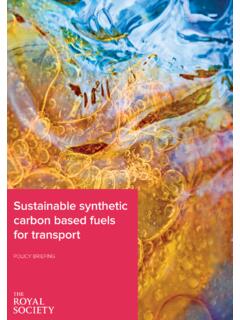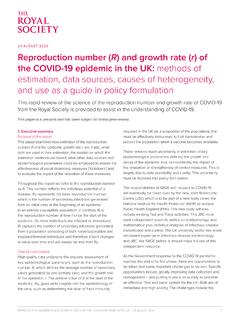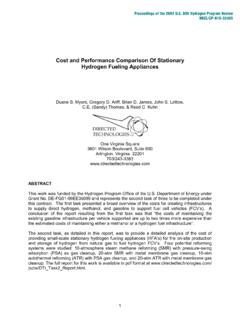Transcription of CLIMATE CHANGE : SCIENCE AND SOLUTIONS | BRIEFING 4 …
1 CLIMATE CHANGE : SCIENCE AND SOLUTIONS HYDROGEN AND AMMONIA 1 CLIMATE CHANGE : SCIENCE AND SOLUTIONS | BRIEFING 4 The role of hydrogen and ammonia in meeting the net zero challenge In briefHydrogen and ammonia have important potential roles in a net zero economy as they have no carbon emissions at the point of use. Both fuels are versatile, capable of being produced and used in many ways, including production from renewable sources and applications to decarbonise challenging areas, such as heavy transport, industry, and heat, as well as the storage and transport of energy. They are already widely used in industry and agriculture, but their current production carries a high greenhouse gas footprint.
2 Significant greenhouse gas emission reductions could be achieved through decarbonisation of production for both existing and new applications. However, both fuels currently face challenges that require technological advances, including in their generation, storage and use, particularly the costs involved in achieving net zero life cycle emissions. Further research, development, demonstration, and deployment are required to identify the areas where hydrogen and ammonia can make a critical difference in practice. INSIGHTS Hydrogen and ammonia have the potential to be competitive net zero energy sources and energy carriers for a number of applications.
3 Research, development, demonstration, and deployment are required to gauge that potential more accurately. Hydrogen and ammonia should be prioritised for demonstration in sectors where they have high potential to be the leading cost-effective low-carbon alternative, such as heavy industry and heavy-duty vehicles, railways, and shipping, as well as energy storage. Demonstration at scale can often be most cost-effectively carried out through clusters of industrial partners, with port regions often being particularly suitable, especially for integration with offshore wind. International collaboration, including on infrastructure, can help to develop the outcomes presented here, building on current pilot projects, and should be coupled with research to drive further innovation.
4 2 CLIMATE CHANGE : SCIENCE AND SOLUTIONS HYDROGEN AND AMMONIA1. Hydrogen and ammonia today Background Hydrogen is the most abundant element in the universe and a well-established energy carrier. It has significant potential in a net zero economy as it can be used in transport, heat, power, and energy storage with no greenhouse gas emissions at the point of use. Ammonia, a compound of hydrogen and nitrogen, is also a powerful zero-carbon fuel . Conventional production and use of hydrogen and ammonia The most common current process for producing hydrogen is steam methane reforming (SMR), known as grey hydrogen1. Each year, around 6% of the world s natural gas and 2% of its coal is used to make grey hydrogen2.
5 Around 51% of the pure hydrogen produced globally is used in refineries, for example to remove impurities such as sulfur from fuels, and around 43% as an input for ammonia synthesis3. Other applications use hydrogen as part of a mixture of gases, including the production of methanol used in industrial applications and chemical manufacture, and the reduction of iron to produce steel using electric arc furnaces. Demand for pure hydrogen has reached around 70 million tonnes per year (MtH2/yr), a threefold growth since the the lightest element, with low volumetric energy density, hydrogen is challenging to store and transport and for many practical uses needs to be compressed or liquefied.
6 These demands mean that today it is typically manufactured close to where it is used. However, there are existing dedicated hydrogen pipeline networks, for example in the US Gulf Coast region, Germany and the Benelux countries4, 5. Ammonia is produced in the Haber-Bosch process where hydrogen is mixed with nitrogen and together processed at high temperature and pressure with a catalyst to produce ammonia6. The most common uses of ammonia are in the production of fertilisers, as a refrigerant and to make plastics and other products. Ammonia (NH3) has higher volumetric energy density than hydrogen and is easier to store and transport. Worldwide production of ammonia is about 175 SMR and Haber-Bosch are based today on the use of fossil fuels such as natural gas and coal.
7 Hydrogen production accounts for 830 million tonnes of CO2 emissions per year (MtCO2/yr), while ammonia production accounts for around 420 MtCO2/yr, together around 2% of annual global greenhouse gas (GHG) emissions7, 8, 9. Safety and environmental considerations of hydrogen and ammonia Both hydrogen and ammonia raise safety concerns that need to be managed. Hydrogen has a very low flashpoint, much lower than gasoline, for example, at -43 C10. However, it needs a higher concentration in air to be flammable, 4% compared to for gasoline, and its low density and high diffusivity in air reduces risk as it dissipates rapidly11, 3. Adequate ventilation and leak detection are important in designing hydrogen systems.
8 Ammonia is corrosive and toxic, and risks are elevated by high vapour pressure under standard conditions. However, ammonia is readily detectable by smell at concentrations well below those that cause lasting health consequences6. While both hydrogen and ammonia have been safely used across several industries for decades, new applications will need to be tested afresh. From an environmental perspective, new ammonia applications will need to be assessed as ammonia-based fertilisers contribute to GHG emissions via nitrous oxide, to biodiversity decline via excess nitrogen, and to air pollution by reacting with other pollutants to form particulates.
9 Research into hydrogen suggests it has only very small effects on the CLIMATE or ozone layer12. In both cases there will be challenges of public acceptability, even if some perceptions do not reflect the real risks CHANGE : SCIENCE AND SOLUTIONS HYDROGEN AND AMMONIA 3 Green hydrogen uses renewable electricity to split hydrogen from water through electrolysis and offers a zero-carbon Low-carbon production and use of hydrogen and ammonia Hydrogen and ammonia offer opportunities to provide low carbon energy and help reach the target of net-zero emissions by 2050. However, decarbonising their production is fundamental as they are currently produced in heavy industries with a sector-level carbon footprint larger than that of several individual G7 countries simply for today s applications13.
10 Low-carbon production of hydrogen There are several ways to produce hydrogen, with varying carbon footprints. In Figure 1 we examine the lower-carbon options of hydrogen production. Blue hydrogen Blue hydrogen is made from a fossil fuel , typically natural gas, with CO2 capture and storage (CCS) being applied. Conventional SMR can be used, although new technologies are now being explored, including auto-thermal reforming (ATR) where energy is provided by introducing oxygen to burn part of the feedstock as opposed to separately burning natural gas14. While not a fully net-zero technology, it is estimated that up to 95% of the carbon emissions can be captured15.











